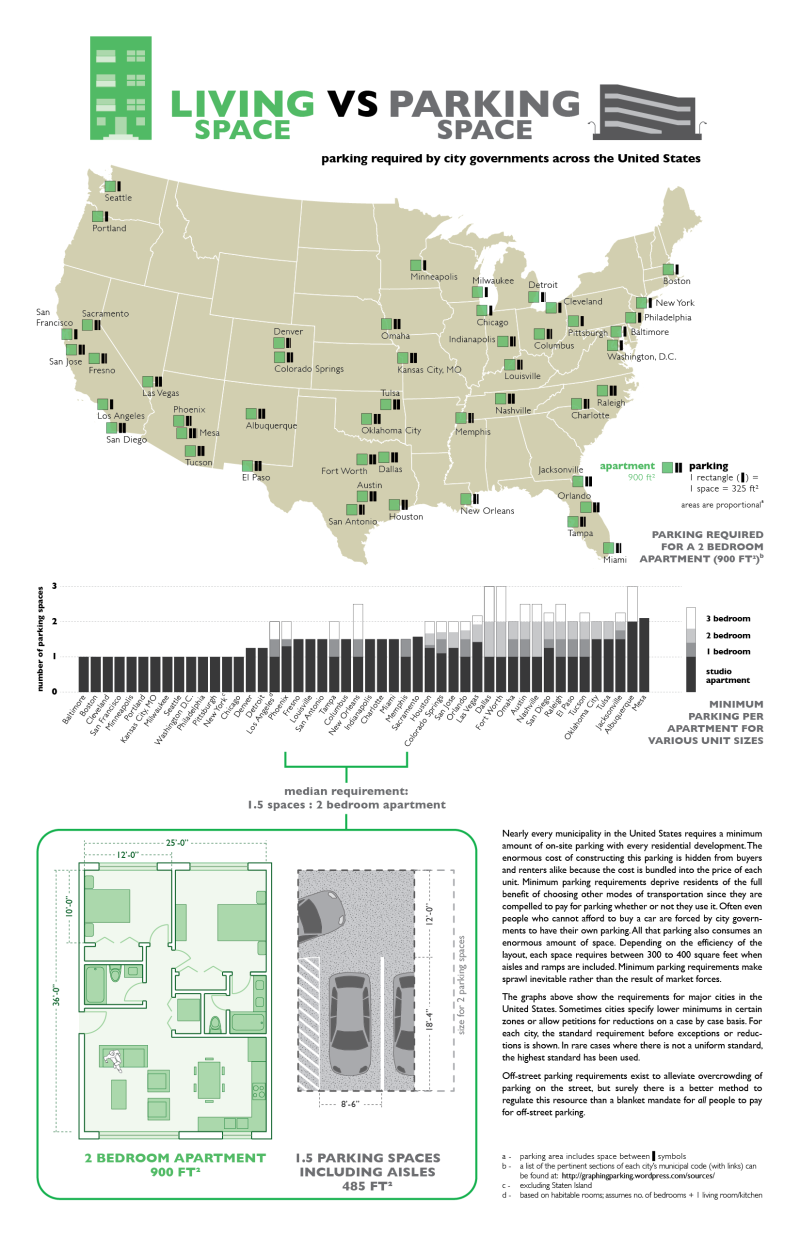This is the first of a five part series. My intention is to demonstrate the prevalence, scale, and inconsistency of parking requirements across the United States for various land uses. This will likely be the least dramatic of the series which will include requirements for restaurants, offices, schools, and places of worship. Even still, this graph starts to reveal regional differences. It also raises questions such as: why would a two bedroom apartment in Omaha need twice the parking as the same apartment in Kansas City, MO? I found the bar graph particularly interesting because cities seem to fall into one of three categories:
1) cities that require one parking space per apartment regardless of size
2) cities that require about one and a half parking spaces per apartment regardless of size
3) cities that have variable requirements but have the most onerous standards for multi-bedroom units
It would seem to me that cities in the first two categories might have a higher prevalence of multi-bedroom units than cities in the third category since the cost of parking could remain constant. One would think that especially in the case of Fort Worth, there would be very few three bedroom apartments. Might there also be an effect on the percentage of families with children that live in multi-unit dwellings? Perhaps young people would be more likely to live with roommates in cities that do not vary their requirements. It would be interesting to test these hypotheses but I’m not sure how to go about that.
Finally, the plans at the bottom of the infographic demonstrate just how big all that parking really is, while hinting at the opportunity cost of building it. Could the person sitting on the couch have afforded an additional bedroom or study if not for the parking? Maybe a balcony or garden space could have replaced the pavement…
An editable PDF version is available here. I invite you to use it freely but ask that you attribute the work.
Updated: 31 March 2013 to reflect more recent source on Dallas



Reblogged this on XoomPark.
Great visual. It’s really scary if you take a minute to think about it. I’m waiting for the promotional tourism video for some city to be “Cars Happy Here!” “Or Come to ____ Your Car Will Thank You” and 30 seconds dedicated not to the outdoor activities or social opportunities of the city, just the parking, highways, crowded streets, and more parking.
Thanks! I assure you the scariest is yet to come.
Pingback: Visualizing America’s Absurd Parking Requirements | Streetsblog Capitol Hill
I’m curious why you have 8’6″ width for parking spaces. That’s typical of what I’ve seen in the midwest, but further East I’ve seen about 7’6″ more often (and 7’1″ at Penn State).
Hi John, that’s a great question. I’ve based my parking measurements on the current version of Architectural Graphic Standards (11th edition). For many cities these are minimum sizes required by code. For example, Boston’s code states, “Each car space shall be located entirely on the lot and shall be no less than eight and one half feet in width and twenty feet in length, exclusive of maneuvering areas and access drives.” §23-9(d)
I suspect that many of the smaller spaces you are seeing might be older and thus grandfathered, although I’m not familiar with the specific laws affecting Penn State. Thanks for asking!
Pingback: » American parking requirements: Massive (mostly), arbitrary, and costly SSTI
Pingback: Parking Minimums and Minneapolis | TheUrbanPath
Pingback: Highways Are Subsidies, Too | Urban Liberty